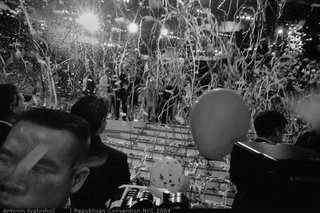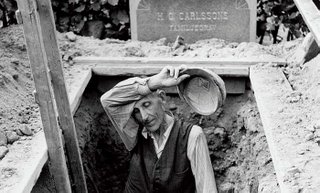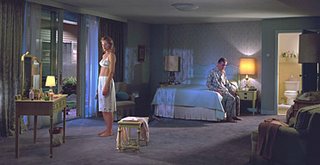
Tuesday, October 31, 2006
Monday, October 30, 2006
Snap Judgements

By James Meyer @ ARTFORUM
AFRICA AND PHOTOGRAPHY have a tangled history. Can the medium that has depicted Africa for the West since the moment of the camera’s invention, during the colonialism of the nineteenth century, escape this troubled past? The thesis of “Snap Judgments: New Positions in Contemporary African Photography” was that this possibility exists not only in theory but in practice among contemporary African artists, who are all too often ignored beyond their homelands. In his impressive introduction to the catalogue, curator Okwui Enwezor states that Western photographic depictions have either aestheticized and exoticized Africa (he cites the work of Leni Riefenstahl and Peter Beard) or represented it as a place imprisoned in a never-ending cycle of famine and political mayhem. “Afro-pessimism” is Enwezor’s term for imagery of the last category, typified by Kevin Carter’s ghastly 1993 photograph of a starving Sudanese child stalked by a vulture (published in the New York Times). According to Enwezor, Afro-pessimistic pictures construct an Africa that is the West’s entropic double, deserving of charity and piteous regard, even as they mystify the West’s long-standing exploitation of the continent’s human and natural resources.
READ ON
Thursday, October 26, 2006
Twelve Undervalued Photographers

by Missy Sullivan @ Forbes Collector
Photography is one of the most steeply rising markets in the collecting world right now. In the New York spring photo auctions, the number of lots that sold for six figures rocketed from 25 last year to 85 this year. And auction records have been shattering at a neck-snapping pace. The world record for a 20th-century photograph hit $822,400 last October, rose to $1.2 million in November, then soared to $2.9 million three months later.
Funny, that only 30 years ago, photography was the art market’s poor stepchild. Since then, more museums have built photographic collections. Scholars have identified the masters of the medium. Art dealers figured out how to successfully market multiples. Conservators have learned much more about materials, techniques and fakes. And as the history of the medium is fleshed out further, more work is being done to identify worthy, lesser-known artists.
READ ON
Tuesday, October 24, 2006
Antonin Kratochvil

In 1996 I spent a month in Russia, during which time I met and hung out with Antonin, indeed an interesting guy.
"As photojournalists go, Antonin Kratochvil has sunk his teeth into his fair share of upheaval and human catastrophes whilst going about his documentation of the time in which he lives.
As people go, Kratochvil's own refugee life has been much in the way the same as what he has rendered on film. Kratochvil's unique style of photography is the product of personal experience, intimate conditioning and not privileged voyeurism."
Visit his site
Read the Russian Chronicles (PDF) - the story of my trip
Monday, October 23, 2006
Different views

@ The Guardian
War, poverty and terrorism, or everyday intimate moments - the camera captures both global events and ordinary lives. Blake Morrison reflects on the history of 20th-century Europe as told in photographs.
As a student, like other students of the era, I stuck photographs of war atrocities round my bed. There was one in particular, which I'd cut from the Sunday Times colour magazine, depicting the My Lai massacre in Vietnam, when US soldiers led by Lieutenant William Calley murdered hundreds of civilians: the photo showed a heap of bloody corpses lying in a ditch. The photos attracted odd looks from less political-minded peers and they didn't do much for my sex life. But though the piety and ghoulishness of having them there now embarrasses me, they weren't merely right-on, in the way a Che Guevara poster would have been. The display was an expression of astonishment that something like this could have happened in our time - out there in the killing fields, away from the sanctuary of the campus. We weren't witnesses, as the photographer had been, but this was history and we were living through it and no one must be allowed to forget.
READ ON
Friday, October 20, 2006
In the Face of History @ Barbican

"From the First World War to the Cold War, the sexual revolution to the Velvet Revolution, communism to capitalism, the 20th Century was marked by sweeping historical events and changes. In the Face of History brings together the work of many of the greatest photographers of this period, whose works collectively map out a century of European experience.
One of the first major exhibitions to chart European photography from 1900 to the present day, In the Face of History features classic photographers such as Eugène Atget, Josef Sudek and Brassaï , alongside contemporary artists such as Boris Mikhailov, Jitka Hanzlová and Wolfgang Tillmans. The exhibition includes a number of photographers from the former Eastern bloc, with many works shown in the UK for the first time. "
13 October 2006 - 28 January 2007
Barbican Art Gallery
Description
List of Photographers
"A Secret History" work of Emmy Andriesse reviewed by Alice Rawsthorn @ The Guardian
Thursday, October 19, 2006
The Still-Life Mentor to a Filmmaking Generation

By RANDY KENNEDY @ New York Times
For much of a half-century of taking quiet, subtly powerful pictures that demand and reward long looking, Jerome Liebling has been known as a photographer’s photographer. The label is both a high compliment and an acknowledgment that Mr. Liebling, now 82, has not enjoyed the acclaim accorded to many of his contemporaries who first took their cameras to the streets of New York after World War II.
But a more fitting way to describe Mr. Liebling would be as a documentarian’s photographer. And judged by that standard, his work has rarely suffered from a lack of attention. In fact, spend any time watching the films of Ken Burns, or those of the legions of documentary makers he has inspired, and you will see Mr. Liebling’s work, in a sense, even if you have never laid eyes on one of his photographs.
READ ON
Tuesday, October 17, 2006
FourThirds System lens catalogue launched

Olympus Imaging Corporation, Matsushita Electric Industrial Co., Ltd. and Sigma Corporation have jointly compiled a detailed catalogue of exchangeable lenses for their digital single-lens reflex camera systems based on the Four-Thirds standard. Supporting companies of Four-Thirds include:
Eastman Kodak Company, Fuji Photo Film Co., Ltd., Leica camera AG, Matsushita Electric Industrial Co., Ltd., Olympus Imaging Corp., Sanyo Electric Co., Ltd., and Sigma Corporation,
"The core design concept of the Four Thirds system is to facilitate optimization of the size, performance, and extendibility of digital cameras and lenses. In addition, a standardized lens mount allows photographers to freely combine interchangeable lenses and cameras from different manufacturers. This is the key feature of the Four Thirds system, the one that makes it possible to explore the full potential of digital photography."
Four-thirds.org site
Monday, October 16, 2006
For Photography, Extreme Home Makeover

By PHILIP GEFTER @ New York Times
Los Angeles
When the J. Paul Getty Museum decided to quadruple its exhibition space for photographs, the obvious goal was to trumpet the breadth of its holdings in the medium: some 31,000 works acquired in a mere two decades.
Yet at a museum best known for Greek pots and old master paintings, the move was also a way of proclaiming the Getty’s relevance to the here and now — and more broadly, affirming photography’s global importance as an art form.
“Photography is our bridge to the modern world,” said Michael Brand, the director of the museum, whose new Center for Photographs opens to the public on Oct. 24. “It’s our only link to the 20th century.”
Photography has become a churning art-world industry: more Chelsea galleries are devoted to photographs; the number of photography books published has dramatically increased; the value of photographs sold at auction annually has doubled since 2001; and even the average size of photographic prints has grown.
READ ON
Thursday, October 12, 2006
The witching hour

Gregory Crewdson's eerie photographs of suburbia at dusk require set-ups as elaborate as a film shoot. He tells Edward Helmore why the world makes sense at twilight
@ The Guardian
The photographer Gregory Crewdson is something of an anomaly in the lunchtime crowd that packs Pastis restaurant in Manhattan's Chelsea district. In dark shorts and T-shirt, he looks more like a top-heavy bicycle courier than a leading figure in America's art scene. But then, Crewdson is an idiosyncratic character given to some fairly idiosyncratic activities: lately he has taken to swimming long distances in the sea off Long Island.
READ ON
Tuesday, October 10, 2006
Rogues' Gallery

Floating in a historical limbo without past or present
by Leslie Camhi @ Village Voice
Years ago, when pictures of missing children were still being printed on milk cartons in New York City, a friend and I shared a macabre preoccupation; we would imagine them morphing into the faces of wanted criminals hanging in the post office. In our fantasies, these two continents of the lost were joined together, each providing the key to the other's mystery. No such closure awaits the unwilling subjects in Least Wanted: A Century of American Mugshots, a show and catalog (published by Steven Kasher/Steidl) of some 200 police photographs of suspected criminals drawn from Mark Michaelson's extensive collection. These alleged shoplifters, car thieves, forgers, and hookers float in a historical limbo without past or present, preserved in shame like flies in amber.
READ ON
Monday, October 09, 2006
Single-pixel camera could simplify imaging
by Jeff Hecht @ New Scientist
A single-pixel camera that captures complete images by taking many snaps with an array of micro-mirrors could consume less power and produce more compact image files than conventional imaging devices, researchers say.
A conventional digital camera focuses light onto a rectangular array of sensing elements, called pixels, which measure light.
The single-pixel camera developed by researchers Richard Baraniuk and Kevin Kelly at Rice University in Houston, Texas, US, takes a completely different approach. It reflects light from 1024 x 768 micro-mirrors onto a single photodiode. Then it changes the arrangement of micro-mirrors and repeats the process – all in a split second.
READ ON
A single-pixel camera that captures complete images by taking many snaps with an array of micro-mirrors could consume less power and produce more compact image files than conventional imaging devices, researchers say.
A conventional digital camera focuses light onto a rectangular array of sensing elements, called pixels, which measure light.
The single-pixel camera developed by researchers Richard Baraniuk and Kevin Kelly at Rice University in Houston, Texas, US, takes a completely different approach. It reflects light from 1024 x 768 micro-mirrors onto a single photodiode. Then it changes the arrangement of micro-mirrors and repeats the process – all in a split second.
READ ON
Friday, October 06, 2006
Yang Yong

Tang Gallery, Bangkok, Thailand
by Brian Curtin @ Frieze
The initial impression Yang Yong’s photographs make is one of self-consciousness. All the photographs are of women ostensibly posing in a variety of urban settings, and the images generically reflect different types of representation: snapshots, fashion photographs and stills from over-styled art films. Most were taken in artificial light, both exterior and interior, and some are nearly monochrome, glowing with a vivid orange or green light. For the installation at Tang Gallery light-boxes stood or hung alongside conventional wall displays. With the gallery’s black floor, grey walls and dimmed lighting Yong’s photographs were luminescent glimpses of a mediated but essentially indistinct urban environment. Temporary and fleeting, it seemed as though the scenes could disappear at any moment.
Read on
Thursday, October 05, 2006
The Paris of Brassaï Goes on Sale

By ALAN RIDING @ NY Times
PARIS, Sept. 29 — Along with the likes of Andre Kertesz, Henri Cartier-Bresson, Robert Doisneau and Willy Ronis, the Hungarian-born photographer who went by the name of Brassaï helped to create the black-and-white images that to this day define mid-20th-century Paris as a city of romance and mystique.
Brassaï’s specialty, developed in the late 1920’s and 30’s while roaming the city’s streets with his fellow flâneur Henry Miller, was Paris by night, both the wintry, misty solitude of the walkways beside the Seine and the intense, oft-decadent social life of the city’s bars, nightclubs and brothels.
READ ON
Wednesday, October 04, 2006
Eye-Fi coming soon

The much-buzzed-about Eye-Fi SD WiFi card is set to go into beta testing later this month. The card doesn’t require specialized drivers and will supposedly work with any camera that’s been “qualified by Eye-Fi,” letting you wirelessly transfer photos directly from your camera to your PC or to select websites.
EYE-FI website
Monday, October 02, 2006
Henry Wilhelm Interview

Henry talks to Vincent Oliver (photo-i) about advances in inkjet printing at Photokina in Cologne.
View the video (Quicktime)
Subscribe to:
Posts (Atom)